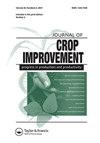GC - MS analysis of guttation fluids from selected crop plants
IF 1.5
Q3 AGRONOMY
引用次数: 4
Abstract
ABSTRACT Guttation is the mechanism by which liquid exudes from hydathodes located on the tip, along the margins, and on the adaxial and abaxial surfaces of leaves. In contrast to stomata, hydathodes, also known as water stomata or water pores, are often open, representing the path of least resistance to liquid outflow from them. Guttation fluids are made up of several organic compounds. This paper focuses on the defensive properties of the chemical compositions of the guttation extracts of Oryza sativa, Momordica charantia, Luffa acutnugula, and Ricinus communis extracted using five different solvents, which were analyzed using Gas Chromatography–Mass Spectrometry (GC-MS). The mass spectra of the compounds present in the guttation fluids were matched by the National Institute of Standards and Technology (NIST) library. GC-MS analysis of guttation fluid extracts of crop plants revealed the existence of compounds with antifungal and antimicrobial properties which may act as barriers to pathogens. The numerous compounds found in plant extracts, such as fatty acids, organic acids, and terpenoids, have a wide range of protective activities and mechanisms that can serve as the first line of defense against pests and diseases.几种作物分泌物的GC-MS分析
摘要:排水是液体从位于叶片顶端、边缘以及近轴和远轴表面的水螅中渗出的机制。与气孔相反,Hydrathode,也称为气孔或气孔,通常是开放的,代表对液体流出阻力最小的路径。排水液由几种有机化合物组成。采用气相色谱-质谱联用技术对五种不同溶剂提取的水稻、苦瓜、麻瓜和Ricinus的去内脏提取物的化学成分进行了研究。滴液中存在的化合物的质谱由美国国家标准与技术研究所(NIST)文库匹配。对作物分泌物提取物的GC-MS分析表明,存在具有抗真菌和抗菌特性的化合物,这些化合物可能对病原体起到屏障作用。植物提取物中发现的许多化合物,如脂肪酸、有机酸和萜类化合物,具有广泛的保护活性和机制,可以作为抵御病虫害的第一道防线。
本文章由计算机程序翻译,如有差异,请以英文原文为准。
求助全文
约1分钟内获得全文
求助全文
来源期刊

Journal of Crop Improvement
Multiple-
CiteScore
3.30
自引率
7.70%
发文量
42
期刊介绍:
Journal of Crop Science and Biotechnology (JCSB) is a peer-reviewed international journal published four times a year. JCSB publishes novel and advanced original research articles on topics related to the production science of field crops and resource plants, including cropping systems, sustainable agriculture, environmental change, post-harvest management, biodiversity, crop improvement, and recent advances in physiology and molecular biology. Also covered are related subjects in a wide range of sciences such as the ecological and physiological aspects of crop production and genetic, breeding, and biotechnological approaches for crop improvement.
 求助内容:
求助内容: 应助结果提醒方式:
应助结果提醒方式:


